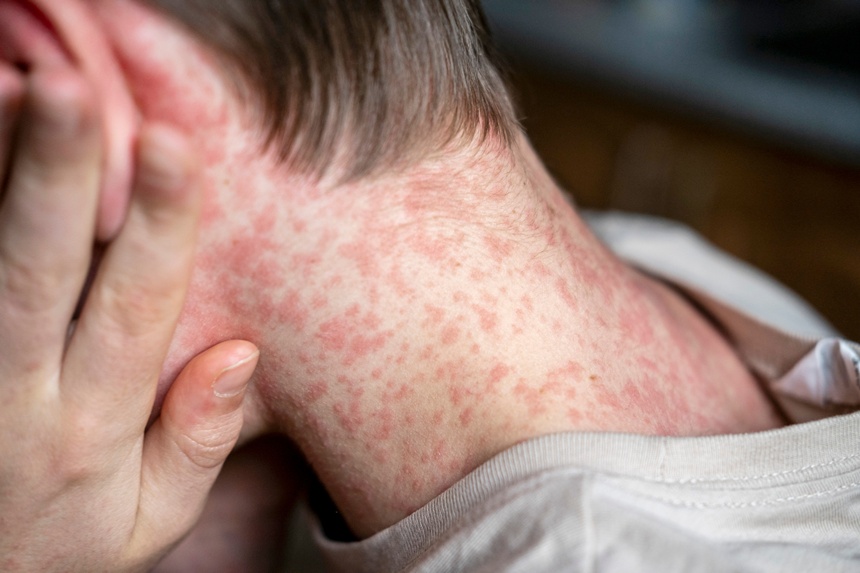Measles is in the news once again, with hundreds of cases across various states and two confirmed deaths as of April 2025. Vaccination remains a hot political topic, as it has been for decades. What is measles anyway, why is it such a big deal, and what is going on in the 2025 measles outbreak?
The measles virus is one of the most contagious diseases known to humankind. More than 90 percent of susceptible individuals will become ill after being exposed to the virus. Prior to the invention of vaccines, almost everyone suffered a measles infection at some point in childhood. The scientific description of measles is credited to the 9th century Persian physician Rhazes. The measles virus causes an acute infection with high fevers, malaise, cough, runny nose, and a characteristic rash. In severe cases this could progress to pneumonia, respiratory failure, seizures, and death.
Measles was once considered a highly lethal disease, almost as bad as smallpox. Children with malnutrition and vitamin deficiencies are especially vulnerable to measles. The World Health Organization estimates that measles caused 2.6 million deaths annually prior to the advent of vaccination. Case fatality rates as high as 25 percent have been reported in developing countries and historical manuscripts, whereas case fatality rates are much less than 1 percent in modern settings. A 1989 U.S. outbreak reported 1.5 deaths per 1,000 reported cases (0.15 percent).
After the acute phase of measles infection, most patients will make a full recovery and enjoy lifelong immunity against measles. A small minority of patients will suffer permanent injury from measles, including seizures, blindness, deafness, or intellectual disability. Measles remains the most common cause of childhood blindness in developing countries across the world. In extremely rare cases, measles can cause subacute sclerosing panencephalitis (SSPE), a neurodegenerative disease that is usually fatal. Even patients who have fully recovered from measles infection can experience measles immune amnesia, a phenomenon where the immune system loses the ability to produce antibodies against some non-measles infections.
The 2025 U.S. measles outbreak includes a total of 712 cases as of April 10, 2025. This is the largest outbreak since 2019, when 1,274 measles cases were reported, and the two confirmed deaths are the first U.S. measles deaths since 2015. This is still a small-scale outbreak in absolute terms. For comparison, the 2024 European measles outbreak included 127,350 cases and 38 deaths. However, any uptick in measles infection is always concerning due to how quickly the disease spreads in unvaccinated populations.
Vaccination is the only intervention that’s proven to stop measles. All measles vaccines are live-virus vaccines, meaning that they use a virus that has been weakened so as not to cause disease. Measles vaccine effectiveness is around 97 percent after two doses, high enough to eradicate the disease if enough people were vaccinated. Measles was declared eliminated in the US in 2000, which means that there is no continuous spread of disease. However, sporadic measles outbreaks have occurred many times since then, and measles has never been eradicated (zero cases) in any country.
The MMR (measles, mumps, and rubella) vaccine has a long track record for safety and efficacy. It has a low rate of severe side effects, including allergic reactions, febrile (triggered by fever) seizures, and immune thrombocytopenic purpura (a blood disorder where the immune system attacks platelets). Vaccine-associated measles has been reported but is exceptionally rare, and patients with vaccine-derived measles do not appear to shed transmissible virus. Since MMR is a live-virus vaccine, it should not be given to pregnant women, the acutely ill, or immunosuppressed individuals.
The claim that measles or MMR vaccination causes autism has been central to the anti-vaccination movement since 1998, when a since-retracted paper by Andrew Wakefield suggested that measles vaccination could be linked to both inflammatory bowel disease and autism. Since then, multiple larger studies have shown no association with autism.
Over 90 percent of American children receive two doses of the MMR vaccine by age 17. This is comparable to measles vaccine coverage in other high-income countries such as Germany, France, or Spain. On the other hand, measles vaccine coverage is less than 80 percent in Bosnia and Herzegovina, Montenegro, North Macedonia, and Romania, countries that have seen large measles outbreaks.
Some anti-vaccine advocates have claimed that measles can be treated with good nutrition, vitamin A, vitamin C, colloidal silver, selenium, or other supplements. This isn’t entirely crazy, we know that nutrition and vitamin A can greatly decrease both the measles fatality rate and the risk of permanent blindness. However, there is no evidence that nutrition alone can reduce the risk of measles-induced blindness or other neurological damage to zero, nor is there any evidence that it can prevent rare late fatalities from SSPE. In contrast, communities with high vaccination rates have been able to eliminate measles spread. Measles could be completely eradicated with sufficiently high vaccination rates, as has happened with smallpox.
You won’t be surprised to hear that I strongly recommend that everyone adhere to the U.S. recommendation of two doses of MMR vaccine for almost everyone, one at 12-15 months age, and one at 4-6 years. If you did not receive both shots of the vaccine as a child, or are not sure if you have, you should talk to your primary care physician about MMR vaccination.
While there is limited evidence of waning vaccine immunity, overall vaccine effectiveness for measles remains high across all age groups. Outside of rare scenarios such as cancers and transplants, people fully vaccinated as children do not need to repeat MMR vaccines as an adult.
Become a Saturday Evening Post member and enjoy unlimited access. Subscribe now



